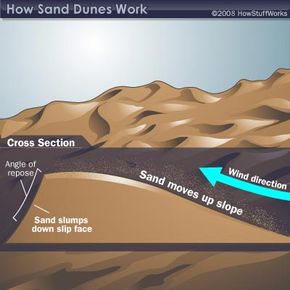Sand Dune Formation
A sand dune needs the following three things to form:
- A large amount of loose sand in an area with little vegetation -- usually on the coast or in a dried-up river, lake or sea bed
- A wind or breeze to move the grains of sand
- An obstacle that causes the sand to lose momentum and settle. This obstacle could be as small as a rock or as big as a tree.
Where these three variables merge, a sand dune forms. As the wind picks up the sand, the sand travels, but generally only about an inch or two above the ground. Wind moves sand in one of three ways:
Advertisement
- Saltation: The sand grains bounce along in the wind. About 95 percent of sand grains move in this manner.
- Creep: When sand grains collide with other grains -- like clay or gravel -- causing them to move. Creep accounts for about 4 percent of sand movement.
- Suspension: Sand grains blow high in the air and then settle. About 1 percent of sand moves this way.
[source: USParkInfo.com]
Once it's in motion, sand will continue to move until an obstacle causes it to stop. The heaviest grains settle against the obstacle, and a small ridge or bump forms. Because the obstacle breaks the force of the wind, the lighter grains deposit themselves on the other side of the obstacle. Eventually, the surface facing the wind crests, and the lighter grains of sand cascade down the other side, or the slip face. This is how a sand dune may actually move over time -- it rolls along, maintaining its shape as it goes.
How and why does a sand dune crest? As the wind moves sand up to the top of the sandpile, the pile becomes so steep it begins to collapse under its own weight, and the sand avalanches down the slip face. The pile stops collapsing when the slip face reaches the right angle of steepness for the dune to remain stable. This angle, which scientists call the angle of repose, is usually about 30 to 34 degrees.
After enough sand builds up around an obstacle, the dune itself becomes the obstacle, and it continues to grow. Depending on the speed and direction of the wind and the weight of the local sand, dunes will develop into a different shapes and sizes. Stronger winds tend to make taller dunes; gentler winds tend to spread them out. If the direction of the wind generally is the same over the years, dunes gradually shift in that direction. Any vegetation that crops up will stabilize the dune and prevent it from shifting.
The fact that sand dunes migrate is fascinating because it makes them seem alive. But their migration actually threatens local agriculture and towns. In China, for example, sand dunes have been advancing upon some villages at the rate of 65 feet (20 meters) per year [source: NASA]. In many cases, fencing will arrest sand dune migration. In some cases, people actually drench the sand with crude oil to stop the movement -- not the most environmentally-friendly solution. Migrating dunes may even collide and merge into one large dune. Or they create the illusion of passing through each other [source: O'Connor].
